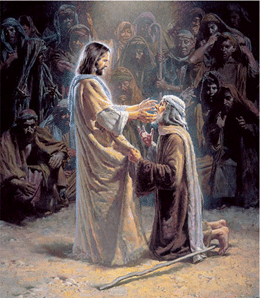Mar
30
Why the Gospels Differ
When reading through and comparing the four canonical Gospels, Christian and non-Christian alike will sometimes wonder why the books aren’t in the same format and tell the same stuff. True, they do follow the basic style for biography in the ancient Greco-Roman world (which can be frustrating to us ‘modern’ people who want more complete information). But, why do they use different titles for Jesus? Why do they sometimes overlap but not always give the same details? Why don’t they always stick to a timeline?
 The answers to these questions and more lie in the original, primary audiences to which each Gospel-writer (or “evangelist”) was writing and the purposes he had in mind for writing his gospel account. What was he — rather, God through him — trying to teach?
The answers to these questions and more lie in the original, primary audiences to which each Gospel-writer (or “evangelist”) was writing and the purposes he had in mind for writing his gospel account. What was he — rather, God through him — trying to teach?
The following is another entry from “My Conversation with Michael the Heathen Gnostic” — an online discourse with a skeptic some years ago. It is a brief summary of the purpose/focus for each of the Gospels. (I don’t remember my source(s) for putting together this info, sorry.)
“As Phil mentioned, each of the Gospels stresses some elements of Christ’s life and ignores others, according to each author’s purpose for writing. Matthew’s audience was the Palestinian Jews, so he emphasizes Jesus’s being the Messiah and King who fulfills the promises & predictions of the Hebrew Scriptures. He includes many quotations from the O.T. and devotes attention to details about contemporary Jewish life and religious customs. Matthew also pays particular attention to Jesus’ teaching ministry and tends to group together into blocks sections that have similar instructional themes.
Mark, on the other hand, concentrates on Jesus as the Conqueror over Satan, sin, sickness & death. He emphasizes Jesus the Man, the Servant who suffered, focusing on His actions & redemptive deeds over philosophy & theology. He stresses Christ as the “Son of God” and Redeemer. Mark traveled with Peter quite a bit, and it is quite possible that much of his Gospel is a summarization of Peter’s presentation of Christ’s life & works. It is usually considered the first written, though some prefer Matthew.
Luke’s purpose was to present a (relatively) complete, historically accurate biography of Jesus as the perfect “Son of Man”, showcasing His virtues and incredible tenderness in dealing with people. This is particularly evident in his telling of Jesus’ dealings with women & children, as well as social outcasts like lepers & Samaritans. As an educated Greek physician, Luke took special interest in medical matters and in Christ’s healing miracles. His Gospel also pays the most attention to presenting events in chronological order.
John’s purpose was to show his readers that “Jesus is the Christ, the Son of God, and that believing [they might] have life in His name.” (20:31) Unlike the Synoptists, John used a highly selective, stylized presentation, organized around seven miracles that Jesus performed, “signs” that revealed His Divine nature. (Note: The number 7 signifies perfection or completion in Jewish culture.) Each of these is rooted in O.T. understanding of the Messiah, thus helping to point to Jesus as the fulfillment of O.T. promises, and that He alone offers everlasting life.”
Sometimes we forget that the Gospel-writers were very different individuals with different backgrounds, different education, different personalities, different writing styles, etc. Rather than have them write the exact same thing, it makes sense that God would have them each focus on different aspects of Jesus’ identity and ministry. Each one provides different pieces of the ‘puzzle’, while all contributing to the same, harmonious picture.
I don’t know about you, but next time I read through the Gospels, I think I’ll read this first as a sort of primer to remind me what to expect. I hope you find it helpful, as well.
















